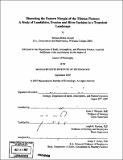Dissecting the eastern margin of the Tibetan plateau : a study of landslides, erosion and river incision in a transient landscape
Author(s)
Ouimet, William Burke
DownloadFull printable version (27.22Mb)
Other Contributors
Massachusetts Institute of Technology. Dept. of Earth, Atmospheric, and Planetary Sciences.
Advisor
Kelin X. Whipple and Leigh H. Royden.
Terms of use
Metadata
Show full item recordAbstract
The eastern margin of the Tibetan plateau is characterized by large rivers dissecting regional topography that has been uplifted in association with the continued convergence of the Indian subcontinent and Eurasia. In this thesis, I utilize field observations, digital topographic data, cosmogenic isotope data, low-temperature thermochronology and numerical simulations to better understand the evolution of these rivers and tectonics of the region. The goals of this work are: 1) to characterize the rates and processes of river incision and erosion associated with major rivers dissecting the eastern margin; 2) to better understand and constrain the transient landscape evolution that defines regional topography; and 3) to move closer to understanding the relationships among tectonics, topography and erosion that apply directly to the eastern margin, and may be applied to other landscapes around the world. To accomplish these goals, I study the rates and processes of river incision and erosion on the eastern margin on a variety of spatial and temporal scales. I discuss local incision processes and related landforms by exploring the influence of large landslides and discussing epigenetic gorges, which are secondary bedrock-walled channels that form in relation to episodes of river blockage or afgradation. I quantify short-term (102-105 yr) erosion rates using cosmogenic isotopes ( Be) from river sand for 65 small river basins (typically <100 km2) throughout the eastern margin, and long-term (106-107 yr) incision rates using low-temperature thermochronology from elevation transects collected within the Dadu, Yalong, and Yangtze river gorges. (cont) Each short-term, basin-averaged erosion rate represents erosion for a unique subset of eastern margin topography, lying within the context of the large-scale transient morphology of the region; while the long-term incision rates quantify the onset and rates of rapid incision associated with regional scale river response to plateau uplift. All of these datasets combine to provide a valuable example of a large, actively evolving transient river with spatially variable erosion and incision, from which can be drawn implications for regional tectonics and models of river incision and landscape evolution, in general.
Description
Thesis (Ph. D.)--Massachusetts Institute of Technology, Dept. of Earth, Atmospheric, and Planetary Sciences, 2007. Includes bibliographical references.
Date issued
2007Department
Massachusetts Institute of Technology. Department of Earth, Atmospheric, and Planetary SciencesPublisher
Massachusetts Institute of Technology
Keywords
Earth, Atmospheric, and Planetary Sciences.